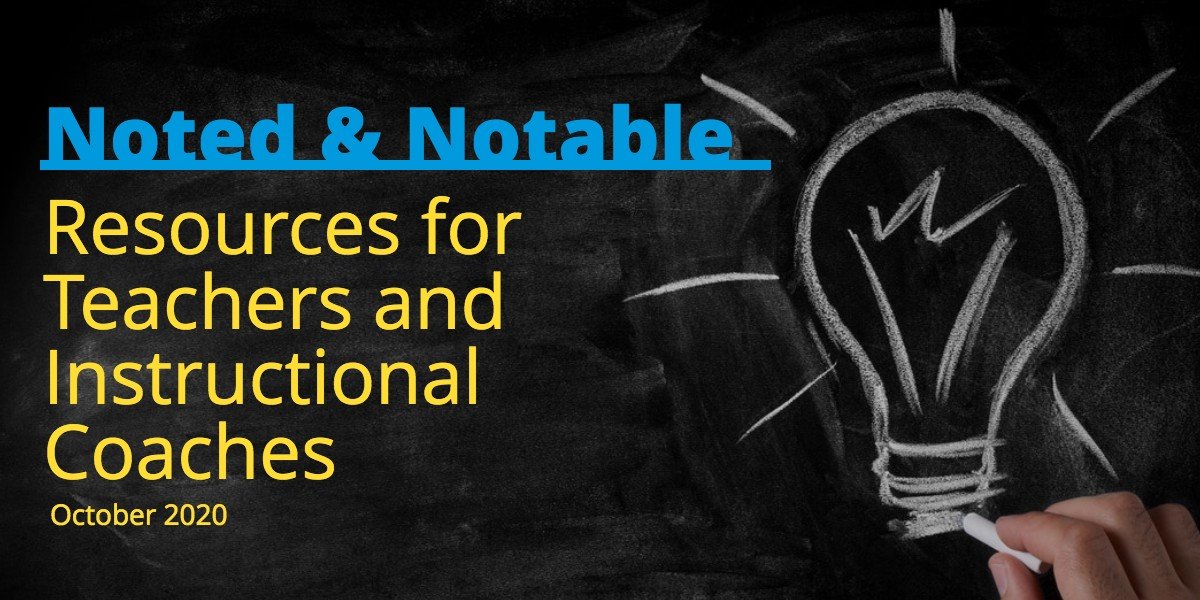Top Resources for Instructional Coaches and Teachers – October 2020

It’s October, and just because we may be in some spooky times call doesn’t mean we need spooky articles. This is all treat and no trick.
Here are some recommended resources for instructional coaches and teachers that will lead to less a haunted virtual or live classroom this year. The list of articles includes material on student choice, designing virtual professional learning activities, and lessons learned from the distribution of funds from the CARES Act.
A sense of community, collaboration, personalized learning, and reflection are all critical components of remote professional learning
The job of a professional learning coach has drastically changed as a result of virtual learning. Here are four design elements for facilitators who are hoping to plan successful virtual professional learning activities.
We learn best when we are in a safe and supportive environment. As Zaretta Hammond notes in Culturally Responsive Teaching and the Brain, “The brain seeks to minimize social threat and maximize opportunities to connect with others in community.” The design of professional learning should purposefully shift participants from individuals to a community of learners by creating a culture that allows for empathy, collaboration, and genuine dialogue.
At first glance, doing this in a virtual environment might seem like a daunting task, but when we utilize digital tools and an intentional approach, remote professional learning can lead to this type of community.
The facilitator should set the tone by making reference to the group as a community of learners and by establishing norms at the beginning of each session that encourage a safe and collaborative environment. Referring to these norms and reminding participants of them at the beginning of each session helps minimize social threat. Addressing participant responses (from participants sharing both by microphone and through chat) and calling participants by name assists in setting up an inclusive environment.
Read more on Edutopia: 4 Key Elements for Designing Remote Professional Learning
District administrators list flexibility and forward-planning as the best practices they’ve been learning
Administrators share best practices and lessons learned after having used the CARES Act federal funds to support professional development.
Professional development courses on how to implement distance learning are in high demand. School districts across the country are looking for ways to meet that need. Many are supporting professional development with federal funds and improving practices along the way.
“In the 2019-20 school year, CARES Act funds were used to support professional learning last spring in the amount of $19.02 million,” explains Nicole Stewart, Jeffco Public Schools interim chief financial officer. “In addition, professional development was provided at the beginning of the 2020-21 school year; however, a dollar amount has not yet been allocated to the CARES Act funds.”
States have additional flexibilities for ESSA under the CARES Act as the U.S. Education Department allows states to request a waiver to the definition of professional development under ESSA Section 8101(42) for activities funded for SY 2019-20. Additionally, ESSA Section 1114(a)(1), Section 1114(b)(7)(A)(iii)(IV), Section 1115(a), and Section 1115(b)(2)(d) offer LEAs professional development opportunities to help teachers increase their knowledge of the subjects they teach, ways to improve instruction, and acquire proficiency in the use of technology for teaching.
Read more on District Administration: 5 Lessons Learned After PD Paid For By CARES Act Funds
A first-step for designing rigorous student activities: give students a choice
When schools think about designing curriculum this year, many of them are focusing on the importance of student choice. This encourages student ownership of the activities in their own learning. Districts that included student choice into their instructional design had a simpler time during the switch to remote learning.
With districts and schools in various stages of returning to in-person learning, instructional design must be flexible in order to meet the needs of students in many different learning situations. Educators grappling with instructional design can learn from schools that have employed principles of personalized learning. I’ve consulted with many schools and districts on how to make the shift to personalized learning and have learned lessons about how to improve effectiveness. At the top of the list is the lesson that schools need to ensure they are providing students with rigor and relevance in order to make the learning stick, regardless of whether students are learning in person, remotely, or in a hybrid model.
Rigor and relevance help students become complex thinkers. Both in and beyond school, students will have to work in teams with individuals from varied backgrounds to make choices and complete difficult tasks. Relevance helps students see the value of what they’re learning and rigor ensures they are challenged to develop advanced skills and knowledge. Rigor and relevance are also important for equity, because they ensure that all students have access and entry points to high-level content and skills.
Read more on Learning Forward: The Importance Of Adding Rigor and Relevance To Instruction

